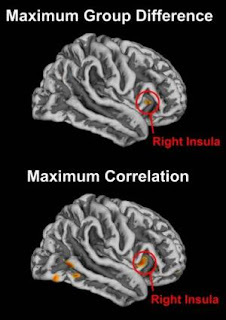Earlier evidence out of UCLA suggested that meditating for years thickens the brain (in a good way) and strengthens the connections between brain cells. Now a further report by UCLA researchers suggests yet another benefit.
Eileen Luders, an assistant professor at the UCLA Laboratory of Neuro Imaging, and colleagues, have found that long-term meditators have larger amounts of gyrification ("folding" of the cortex, which may allow the brain to process information faster) than people who do not meditate. Further, a direct correlation was found between the amount of gyrification and the number of meditation years, possibly providing further proof of the brain's neuroplasticity, or ability to adapt to environmental changes.
The article appears in the online edition of the journal Frontiers in Human Neuroscience.
The cerebral cortex is the outermost layer of neural tissue. Among other functions, it plays a key role in memory, attention, thought and consciousness. Gyrification or cortical folding is the process by which the surface of the brain undergoes changes to create narrow furrows and folds called sulci and gyri. Their formation may promote and enhance neural processing. Presumably then, the more folding that occurs, the better the brain is at processing information, making decisions, forming memories and so forth.
"Rather than just comparing meditators and non-meditators, we wanted to see if there is a link between the amount of meditation practice and the extent of brain alteration," said Luders. "That is, correlating the number of years of meditation with the degree of folding."
Of the 49 recruited subjects, the researchers took MRI scans of 23 meditators and compared them to 16 control subjects matched for age, handedness and sex. (Ten participants dropped out.) The scans for the controls were obtained from an existing MRI database, while the meditators were recruited from various meditation venues. The meditators had practiced their craft on average for 20 years using a variety of meditation types -- Samatha, Vipassana, Zen and more. The researchers applied a well-established and automated whole-brain approach to measure cortical gyrification at thousands of points across the surface of the brain.
Cortical Surface Shown is the lateral view of the right cortical surface. The red circle indicates where the maximum effect occurred. Top: Larger gyrification in 50 long-term meditators compared to 50 well-matched controls. Bottom: Positive correlations between gyrification and the number of meditation years within the 50 meditators. (Credit: Image courtesy of University of California - Los Angeles)
They found pronounced group differences (heightened levels of gyrification in active meditation practitioners) across a wide swatch of the cortex, including the left precentral gyrus, the left and right anterior dorsal insula, the right fusiform gyrus and the right cuneus.
Perhaps most interesting, though, was the positive correlation between the number of meditation years and the amount of insular gyrification. "The insula has been suggested to function as a hub for autonomic, affective and cognitive integration," said Luders. "Meditators are known to be masters in introspection and awareness as well as emotional control and self-regulation, so the findings make sense that the longer someone has meditated, the higher the degree of folding in the insula."
While Luders cautions that genetic and other environmental factors could have contributed to the effects the researchers observed, still, "The positive correlation between gyrification and the number of practice years supports the idea that meditation enhances regional gyrification."
Other authors of the study included Florian Kurth, Emeran A. Mayer, Arthur W.Toga, and Katherine L. Narr, all of UCLA, and Christian Gaser, University of Jena, Germany. Funding was provided by several organizations, including the National Institutes of Health. The authors report no conflict of interest.
Journal Reference:
Eileen Luders, Florian Kurth, Emeran A. Mayer, Arthur W. Toga, Katherine L. Narr, Christian Gaser. The Unique Brain Anatomy of Meditation Practitioners: Alterations in Cortical Gyrification. Frontiers in Human Neuroscience, 2012; 6 DOI: 10.3389/fnhum.2012.00034
Source: University of California - Los Angeles.
